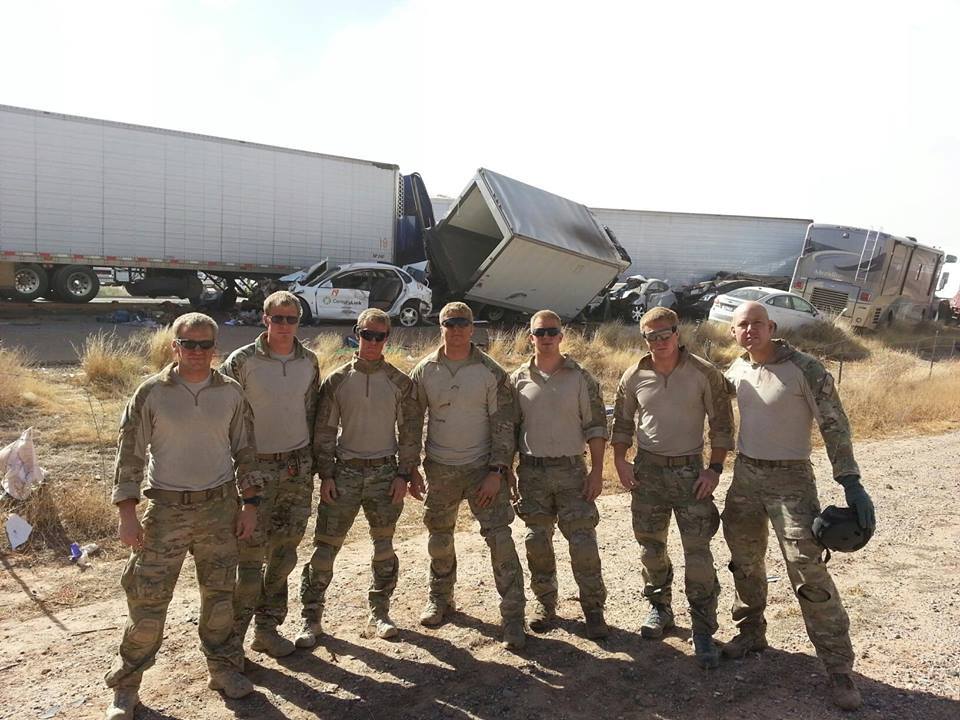 “It is my duty as a pararescueman to save life…” “It is my duty as a pararescueman to save life…”
By Airman 1st Class Betty R. Chevalier
355th Fighter Wing Public Affairs
10/31/2013 – DAVIS-MONTHAN AIR FORCE BASE, Ariz. — Eight Airmen from the 48th Rescue Squadron at D-M were first responders on a 19 vehicle accident involving more than 20 people on Interstate 10 near Picacho Peak, Ariz., Oct. 29.
Six pararescueman, a combat rescue officer and a communications specialist were driving through a dust storm with reduced visibility after jump training in Eloy, Ariz. when they drove by the accident.
“We were driving down Frontage Road when we saw the pile-up,” said Caleb, 48th Rescue Squadron combat rescue officer. “We noticed there were police on either end, but no emergency medical services or rescue at the crash site.”
The Airmen witnessed an individual from the accident walk down the hill from the freeway and then fall down. They consulted with each other and made the decision to turn around and offer their assistance.
When they pulled over to the side of the road, they talked to a sheriff. Lucas, 48th Rescue Squadron pararescueman, identified himself as a U.S. Air Force pararescueman with seven paramedics and asked if the sheriff needed help.
“The sheriff said ‘Right now, I got three dead and five critical, help as fast as you can,'” Lucas said. “At that point, we completely unloaded both of our vehicles.”
They suited up with their military issued helmets, goggles and gloves and headed into the scene with what medical gear they had. The first thing they noticed was fuel leaking onto the road and under vehicles.
“We immediately noticed three or four vehicles with trapped personnel,” said Caleb. “We assessed them and their situations and started getting people out using basic tools and equipment.”
With the Airmen being some of the first on scene, they improvised with knives, crowbars and any other objects they could locate to extract people from their vehicles.
They were on scene about 15 minutes before emergency medical services arrived and 30 minutes before heavy extrication equipment showed up. They triaged, splinted and provided medical care to more than 20 individuals at the crash scene. Additionally, they provided emotional support to patients.
If you find something that will bring a patient comfort, give it to them, said Lucas. Even just going back and asking ‘How are you doing Stanley?’ brought them comfort simply because their name was not forgotten.
The Airmen extracted five people from vehicles, coordinated four medical helicopter flights, and organized ground transportation for about six injured individuals.
After the critically injured were transported off scene, the Airmen collected all of their gear, ensured EMS no longer needed their services and continued back to D-M.
This situation was a first for four of the pararescuemen. They were right out of initial training and had never responded to a real-world incident like this before.
“I’m a Department of Training instructor,” Lucas said. “The fact these Airmen just rolled in and got it done, it’s a great feeling to know they are new and they accomplished something like this. It shows them how they can make a difference.”
All the Airmen credited their training and experience, which allowed them to keep calm and render aid in conjunction with the other authorities at the scene.
“You do all these medical scenarios and train so much, sometimes you wonder, ‘Am I going to know what’s right?'” said Dan, 48th Rescue Squadron pararescueman. “When you get in there and start doing it for real, all your training pays off.” |